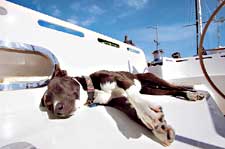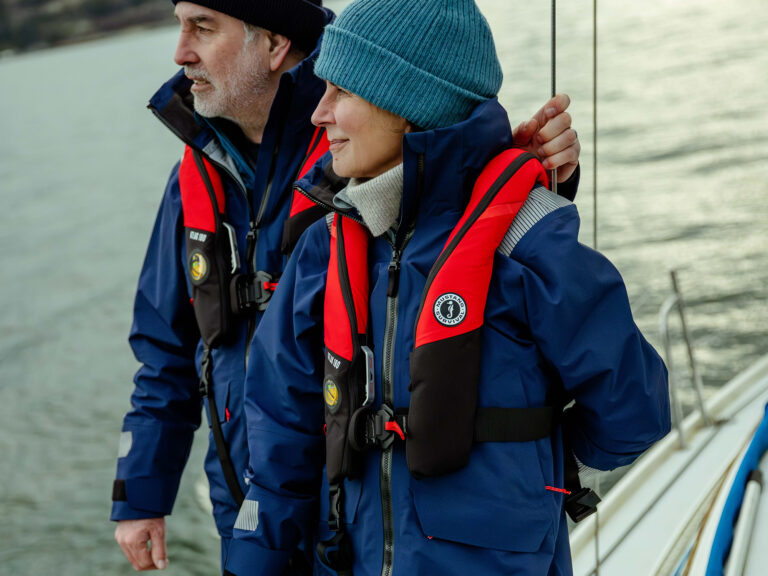Many animal lovers dont cruise with pets because they dont believe animals could be comfortable aboard. In many cases, though, their owners simply need to know how to look after them. For the most part, that means taking the same steps to protect your pet–and to protect your boat from your pet–as you would at home. A few extra precautions, though, are in order.
Bringing pets aboard raises many of the same concerns as youd have for any nonsailors: making sure they dont fall overboard, being able to get them back in case they do, preventing seasickness and heat exhaustion, and being prepared to handle an accident.
Basic Safety
Properly fitted and sized, pet-flotation devices (PFDs) work just as well for cats and dogs as they do for the rest of the crew. The trick is to find one that fits your pet snugly, that won’t constrict its movement, and that the animal will actually wear. Most marine stores will allow you to try the PFD on your pet, as long as the device stays clean and dry. Once you’ve found one that your pet will wear, give it the dunk test. Let the animal get used to how it feels, then walk it into a calm, safe body of water to see how much support the PFD provides.
To keep track of a pet after dark, attach a light to its harness or PFD. A red light wont affect your night vision, and it makes your pet easy to spot whether the animals in the water or romping along the dock. Ive used a Pelican Flasher (Pelican Products; 800-473-5422, www.pelican.com), a compact, 2-ounce light that will flash for up to eight hours when powered by two AAA batteries. (This light has been replaced by the Mini Flasher, a flashing LED lamp that runs off two coin-cell batteries for 130 hours and makes Fido visible for up to half a mile.)
For traveling to strange ports, get your pet an identity tag, including your boats make and model, name, registration number, and a contact number. Some countries also require pets to have a microchip implanted that carries coded information about the pet, its vaccination history, and its owner.
|
|
| |
|

|
| |
| Billy Black|
| |
|
|
|
Carry a photo of your pet to show around in the event it goes missing.
Comforts of Home
To keep pets comfortable, you have to provide them with food, water, protection from the elements, and a safe place to rest. The Kuranda Dog Bed (Kuranda USA; 800-752-5308, www.kuranda.com) is used by many kennels and also works well on boats. To keep pets dry, its nylon mesh surface is suspended like a hammock from an aluminum or poly-resin frame. The inverted-cone design of the Buddy Bowl, available in specialty stores and online, will prevent water from spilling, even if Rover flips it over.
Seasickness
If you’re uncertain how your pet will react to a long sail, take it on a few short trips. Bring favorite toys, blanket, food, and water from home–waters elsewhere may have a different mineral content, which could trigger diarrhea.
If you find your pet suffers from sea sickness at the start of a voyage, don’t feed it for six hours before setting off. If possible, don’t give it water for two hours before. Feed and water it as soon as it gets its sea legs.
If your pet gets seasick during the cruise, wait until its stomach has calmed sufficiently to hold down liquids, then give it a small amount of milk to settle it further.
Travel-induced stress can cause constipation, and if your pet shows signs of this, add a daily teaspoon of vegetable oil to its food (but dont forget to walk it every time you touch land!). Many dogs wont soil their dens, and if yours perceives your entire sailboat as its den, it might become constipated. If youre planning an extended journey, its therefore vital to first paper-train the animal.
Sunburn
Pets are susceptible to sunburn, just as humans are, and short-haired, pink-skinned animals more so. In most cases, hypoallergenic sunblocks work as well on pets as they do on humans. Try a small test patch first at home.
The likelihood of sunburn can be further increased if your pet is taking certain drugs or medications–antibiotics, tranquilizers (often given to traveling pets) and diuretics. To avoid serious sunburn to a vulnerable area, such as a scar, cover it with either sunscreen lotion (a minimum of 15 SPF) or zinc oxide.
Skin cells expand when theyre damp, thereby causing UV rays to harm a larger amount of tissue. After a swim, be sure to dry your pet as thoroughly as possible. Then reapply sunscreen.
Animals eyes are extremely vulnerable to sun damage, as is the thin skin of their eyelids. Doggles sunglasses (MidKnight Creations LLC; 209-295-2933, www.doggles.com) might give humans a chuckle, but they provide the pooch with wrap-around protection against UV rays or flying bugs. Two adjustable straps hold them in place, side vents keep them from fogging up, and they float. Theyre available in a variety of sizes and colors. Beware of metal frames on sunglasses, which can become very hot.
If your pet does get sunburned, the first treatment is to cool the heated skin. Splash on, spray on, or make a compress of either 3 tablespoons of baking soda blended in 1 quart water, or 1 tablespoon of rubbing alcohol mixed into 2 cups cold water. Alternatively, saturate a towel with cold milk or a solution of strong tea to create a natural, soothing compress and apply it directly to the sunburned areas.
After completing the initial cooling process, coat the sunburned areas to prevent the painful burning sensation caused by oxygen coming in contact with the skin. Aloe vera gel is a traditional remedy for burns. It contains a natural painkiller that works as well on animal skin and aids in the healing process. Plain honey, mayonnaise, and petroleum jelly work equally well. However, you have to prevent your pet from licking off these “homemade” medicines, as the abrasive action of its tongue can further damage the sore tissues and will make the area hurt more.
If blisters form on the damaged skin, treat them in a timely fashion against potential infection. Cleanse the blistered skin gently with a mild soap and water and blot (dont rub) the sore skin dry. To speed the healing process, apply a protective coating of aloe vera gel, petroleum jelly, honey, or Vitamin E (you can snip the vitamin capsules and squeeze the gel drops directly onto the skin).
In cool weather, if your dog spends all day on deck with you as you sail, its skin may become dry, causing the animal to itch–and scratch. A teaspoon of vegetable oil added daily to the food of a standard-size dog (less for miniatures) should stop the itching and make the coat shiny, but discontinue the treatment if diarrhea results.
Handy Tips
Feed the animal smaller amounts at more frequent intervals. (Note: If a lack of appetite is accompanied by other symptoms, such as a fever or shaking, take the animal to a vet.)
To make dry food appealing after it’s sat out all day on deck, mist it with water. This will release fresh food scent.
When water’s low, but your pet desperately needs a bath, you can substitute a dry shampoo made from cornmeal or a 50/50 mixture of flour and oatmeal. Take a handful of either and, working from head to tail, rub it into the animal’s fur, then gently brush your pet clean. You may want to do this in an open area, as an unhappy pet can make a mess.
If your pet gets seasick, clean it up as best you can with lukewarm water, then soak the area for 15 minutes in a mixture of 1 quart warm water, 1/2 teaspoon of liquid detergent, and 1 tablespoon of ammonia. Rinse well.
Wipe pet hair off cabin upholstery with a rough-textured pad, such as a Buff Puff or a facial sponge. Stop hair from adhering by spraying a static-preventer onto all upholstered surfaces.
To keep a chewing puppy away from berths and settees, oil of clove works just as well on a boat as in a home. If the offender is a cat, you could also attach a carpet remnant to the appropriate surface and sprinkle catnip on it to create a makeshift scratching post. Alternatively, wipe down the wood with chili sauce and blot it dry. To stop a pet from chewing on a line or an electrical cord, wipe it down with a dry bar of soap. The bitter taste should quickly break the habit.
If youll be taking your pet along on short trips from home, its usual protection from fleas and ticks should suffice, but before heading for exotic destinations, you may want to consult with your vet on whether extra steps are necessary.
One pestilence your pets sure to encounter is mosquitoes. Avon Skin-So-Soft works as well to repulse them from dogs and cats as it does humans. If your pet has sensitive skin, you may want to do a tiny test patch first.
Pale, white gums are a symptom of shock or an anemic reaction to fleas, ticks, or worms. Take the animal to a vet as soon as you can.
If your pet does bring fleas on board, Borax will get rid of them (as well as stray cockroaches) quickly and nontoxically. Lightly cover carpets and cabin upholstery with Borax, allow it to sit for a few hours, then vacuum. Reapply the Borax generously; this time, let it sit for a few days until the flea eggs hatch, then vacuum it up completely. Use the vacuum nozzle on all corners and crevices where eggs may have been laid. Toss a couple of mothballs into the vacuum bag to kill any fleas that might have been taken alive.
Evict fleas from your bedding by placing cedar shavings or pine needles beneath the mattress; if youre storing the boat, place the shavings or needles both below and on top of the mattress. The smell will drive the fleas to more comfortable surroundings, hopefully to die in your Borax-treated carpeting. Salt repulses fleas, so wash an infested pet bed in a briny mixture of salt and water.
Bill Lindsey, a native of Florida, grew up on the water and bought his first boat when he was 6. Hes presently shopping for a racing sailboat.








